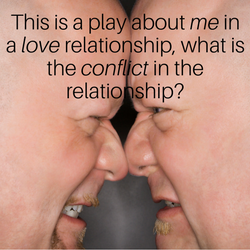Guidepost #2 – Conflict
by Megan Donahue
The core acting curriculum at Acting Studio Chicago is based on the 12 Guideposts from Michael Shurtlef’s Audition. The concept of Conflict is essential to script analysis. Having a shared language, vocabulary and philosophy about the actor’s approach to text means that there is a consistency and a specificity to our training.
In this series of posts, we invite our faculty to comment on a single Guidepost.
The second Guidepost is Conflict. Conflict is the root of all drama, and the driving force of much of the actor’s work. We like to phrase it as “What am I fighting for?” The actor decides what he or she wants, more than anything else (their “dream”) and then sets about attempting to change or affect their partner to make that thing happen. When two actors in relationship are each fighting for what they want, conflict is inevitable and drama happens.
Rachael Patterson, Studio Director: Every meaningful relationship in our lives contains conflict. As actors we are always seeking to identify that conflict in the relationship; the problem with the OTHER person. This does not mean that we are always FIGHTING, but it does mean that there is an underlying, on-going and constant problem. And it is when things heat up in the story/plot/situation, that the conflict in the relationship rises to the surface.
Our level 2 teachers, Jennie Moreau and Gretchen Sonstroem offered their thoughts on this Guidepost.
Jennie: The conflict drives the scene. I think it’s important to understand that “What are you fighting for?” doesn’t necessarily mean something negative. It really means “What is my dream? And why? And what’s at stake?” It’s closely tied to Relationship—what is the conflict between me and the other person? I think it’s easy for students to hear “conflict” and think “I’m just going to play anger and scream at you” but it’s much deeper.
Gretchen: I always start with relationship, the actor’s dream, and their “fighting for.” Once you have a good juicy dream, you can start asking, “What is wrong with the other person, and how aren’t they working with my dream?” Sometimes the conflict in a scene is obvious, but one of the things I like about teaching Conflict is the way it helps actors understand subtext. If you’re thinking in black and white about your conflict you’re probably going to choose black and white ways to try to get what you want. Choosing to fight for something specific and nuanced allows you to choose more interesting ways to get what you want.
Check out our CORE PROGRAM, in which we introduce the Guideposts.



